-
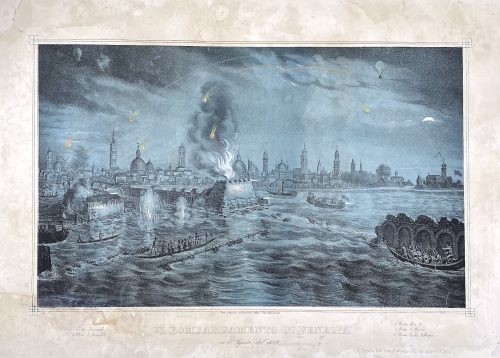 Quaritch's description: Single sheet (435 x 625 mm); coloured lithograph by Kirchmayr after a drawing by M. Fontana; hand-painted details; signed to lower left ‘M. Fon[tana]’ and to lower right ‘M. Fontana Edit. Prop. S. Giacomo dall’Orio in Isola N°.1481’; lower margin with the title ‘Il bombardamento di Venezia nell’Agosto 1849’ and key; restored tears in many places, especially along upper and lower blank margins, some affecting print; losses to lower left corner, affecting a small portion of the print, ruled border, and key, restored and re-drawn where needed; loss to the upper left corner of blank margin; two small areas of restoration to the centre of upper blank margin; the whole sheet backed; nevertheless a remarkable survival. Exceedingly rare and striking lithograph of Venice as seen from Fusina, depicting the first ever aerial bombardment in history. The bombardment took place in 1849, under the orders of Field Marshal Josef Radetzky (1766–1858), to quell the revolts that had started the previous year during the First Italian War of Independence. This curious and little-known action was the brainchild of Colonel Benno Uchatius, a brilliant young officer in the Austro-Hungarian Artillery. After long months of unsuccessful siege, Uchatius decided to deploy an unusual weapon: a hot air balloon able to bomb the city from above. Having calculated the wind speed and direction and evaluated the requisite dimensions of the hot-air balloon, Uchatius set up a workshop near Mestre, where a group of engineers and craftsmen began to manufacture a balloon equipped with a large wicker basket which could transport two crewmen and approximately one hundred kilograms of small long-fuse devices (metal spheres filled with gunpowder, pitch, oil and five hundred rifle buckshot). The initial trials, however, proved to be a disaster, because the balloon would drift off course, making it impossible to accurately deploy the bombs. Uchatius then hit upon the idea of using several smaller unmanned balloons roped together. These were to be launched over the city and, using the position of the first ‘pilot’ balloon, which was unarmed, the Austrians could calculate the correct fuse settings for the bombs. The ‘bomber’ balloons had a cloth envelope of one hundred cubic metres and a reduced load of about twenty kilograms of ordnance. According to Uchatius’ calculations, the line of balloons, launched from Mestre, would reach the lagoon city in thirty-five to forty minutes, carried by the north-west wind. In July 1849, a first launch was attempted, but when a breeze began to blow from the sea some of the balloons broke the connecting ropes and floated away, while others settled in the water in front of the northern part of the city, where a curious crowd of Venetians observed the failure of the enterprise and commented colourfully on the ‘buffoonery of Radetzky’. Uchatius’ second attempt, which is depicted in this lithograph, was also largely unsuccessful: only a few of the unmanned bomber balloons reached their target, and some even drifted back over the Austrian lines. Uchatius, having accomplished the first ever aerial bombardment, and having designed the first ever military ‘drones’, was forced to abandon the project permanently. Another fascinating aspect of this work is the vantage point used to depict the city of Venice, seen here from Fusina, a very rare viewpoint that makes this piece even more remarkable. We were unable to locate any copies in any institution or bibliography. G. Kirchmayr (fl. mid-19th century) is mentioned at British Museum database as "Lithographer active in Venice; related to Venetian painter Cherubino Kirchmayr (b. 1848)?" However, I was not able to find that name on the print. Not much is known of M. Fontana either.
Quaritch's description: Single sheet (435 x 625 mm); coloured lithograph by Kirchmayr after a drawing by M. Fontana; hand-painted details; signed to lower left ‘M. Fon[tana]’ and to lower right ‘M. Fontana Edit. Prop. S. Giacomo dall’Orio in Isola N°.1481’; lower margin with the title ‘Il bombardamento di Venezia nell’Agosto 1849’ and key; restored tears in many places, especially along upper and lower blank margins, some affecting print; losses to lower left corner, affecting a small portion of the print, ruled border, and key, restored and re-drawn where needed; loss to the upper left corner of blank margin; two small areas of restoration to the centre of upper blank margin; the whole sheet backed; nevertheless a remarkable survival. Exceedingly rare and striking lithograph of Venice as seen from Fusina, depicting the first ever aerial bombardment in history. The bombardment took place in 1849, under the orders of Field Marshal Josef Radetzky (1766–1858), to quell the revolts that had started the previous year during the First Italian War of Independence. This curious and little-known action was the brainchild of Colonel Benno Uchatius, a brilliant young officer in the Austro-Hungarian Artillery. After long months of unsuccessful siege, Uchatius decided to deploy an unusual weapon: a hot air balloon able to bomb the city from above. Having calculated the wind speed and direction and evaluated the requisite dimensions of the hot-air balloon, Uchatius set up a workshop near Mestre, where a group of engineers and craftsmen began to manufacture a balloon equipped with a large wicker basket which could transport two crewmen and approximately one hundred kilograms of small long-fuse devices (metal spheres filled with gunpowder, pitch, oil and five hundred rifle buckshot). The initial trials, however, proved to be a disaster, because the balloon would drift off course, making it impossible to accurately deploy the bombs. Uchatius then hit upon the idea of using several smaller unmanned balloons roped together. These were to be launched over the city and, using the position of the first ‘pilot’ balloon, which was unarmed, the Austrians could calculate the correct fuse settings for the bombs. The ‘bomber’ balloons had a cloth envelope of one hundred cubic metres and a reduced load of about twenty kilograms of ordnance. According to Uchatius’ calculations, the line of balloons, launched from Mestre, would reach the lagoon city in thirty-five to forty minutes, carried by the north-west wind. In July 1849, a first launch was attempted, but when a breeze began to blow from the sea some of the balloons broke the connecting ropes and floated away, while others settled in the water in front of the northern part of the city, where a curious crowd of Venetians observed the failure of the enterprise and commented colourfully on the ‘buffoonery of Radetzky’. Uchatius’ second attempt, which is depicted in this lithograph, was also largely unsuccessful: only a few of the unmanned bomber balloons reached their target, and some even drifted back over the Austrian lines. Uchatius, having accomplished the first ever aerial bombardment, and having designed the first ever military ‘drones’, was forced to abandon the project permanently. Another fascinating aspect of this work is the vantage point used to depict the city of Venice, seen here from Fusina, a very rare viewpoint that makes this piece even more remarkable. We were unable to locate any copies in any institution or bibliography. G. Kirchmayr (fl. mid-19th century) is mentioned at British Museum database as "Lithographer active in Venice; related to Venetian painter Cherubino Kirchmayr (b. 1848)?" However, I was not able to find that name on the print. Not much is known of M. Fontana either. -
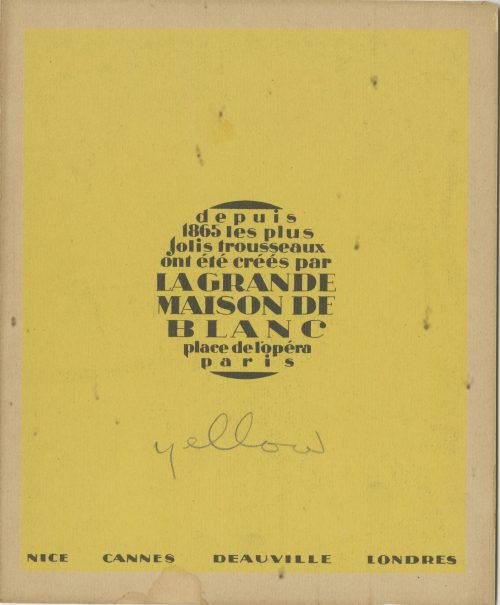 Four chromolithographic plates, each sheet 180 x 150 mm; image 16 x 12.5 cm after Feodor Rojankovsky, signed “Rojan”, titles printed on the back on red (à la chasse), blue (en voyage), green (aux courses), and yellow (depuis | 1865 les plus | jolis trousseaux | ont été créés par | LA GRANDE | MAISON DE | BLANC | place de l’opera | Paris | NICE CANNES DEAUVILLE LONDRES) background. Contributors: Feodor Rojankovsky [Rojan, Фёдор Степанович Рожанковский] (Russian-American, 1891 – 1970) – artist.
Four chromolithographic plates, each sheet 180 x 150 mm; image 16 x 12.5 cm after Feodor Rojankovsky, signed “Rojan”, titles printed on the back on red (à la chasse), blue (en voyage), green (aux courses), and yellow (depuis | 1865 les plus | jolis trousseaux | ont été créés par | LA GRANDE | MAISON DE | BLANC | place de l’opera | Paris | NICE CANNES DEAUVILLE LONDRES) background. Contributors: Feodor Rojankovsky [Rojan, Фёдор Степанович Рожанковский] (Russian-American, 1891 – 1970) – artist. -
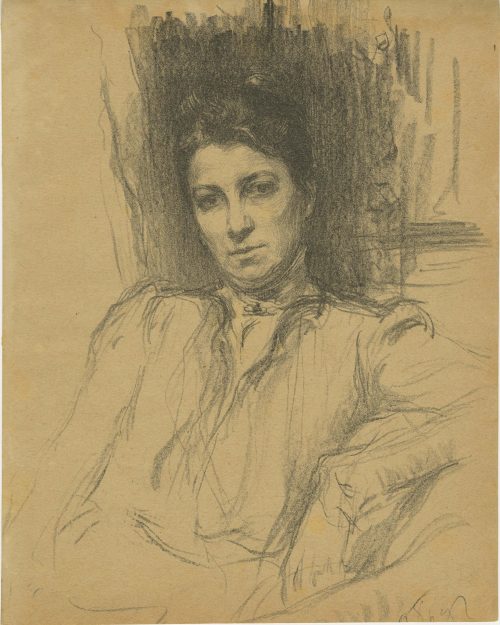
Portrait of Russian actress Maria Gavrilovna Savina, a lithograph on tan paper, by artist Osip Braz, 1900.
Maria Gavrilovna Savina (Мария Гавриловна Савина), a renowned Russian stage actress, born as Maria Podramentsova (Подраменцова) on April 11, 1854 in Kamianets-Podilskyi (Ukraine, Russian Empire) and died on September 21, 1915, in Saint Petersburg. Osip Emmanuilovich Braz (Осип Эммануилович Браз; 16 January 1873 in Odessa - 6 November 1936 near Paris) was a Russian painter of Jewish descent. Imprisoned by the Soviets in 1924 (the Solovki special prison-camp), released in 1926 and emigrated to Germany in 1928. Married to Lola Landshoff. http://russia-ic.com/people/culture_art/b/805/ "All his family members suffered from severe tuberculosis. After losing his wife Lola Lantsgof and both sons, he spent the last year of his life alone. Osip Braz passed away on November 6, 1936, and was laid down to rest at the Bagneux Cemetery in Paris." Buried at Bagneux, Hauts-de-Seine, Île-de-France, France. -
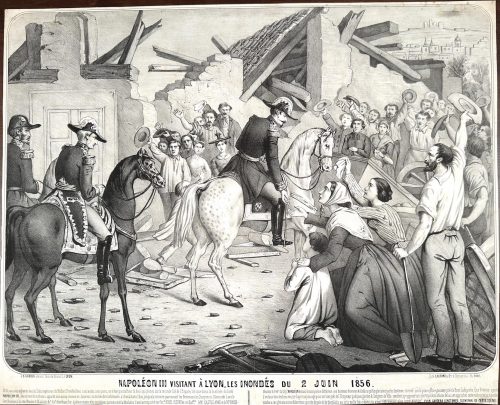 Lithography poster on wove paper, 492 x 614 mm; black ink stamp “5036” to reverse, vertical centerfold. Image in frame; under the frame left: "J. B. Gadola, éditeur. Cours de Brosses 1, à LYON."; right: "Lith LAURANT & Cie r. de Bernardins 34, Paris." Title and text below the image. Jean-Baptiste Gadola (French, 1818 – 1870) – publisher.
Lithography poster on wove paper, 492 x 614 mm; black ink stamp “5036” to reverse, vertical centerfold. Image in frame; under the frame left: "J. B. Gadola, éditeur. Cours de Brosses 1, à LYON."; right: "Lith LAURANT & Cie r. de Bernardins 34, Paris." Title and text below the image. Jean-Baptiste Gadola (French, 1818 – 1870) – publisher. -
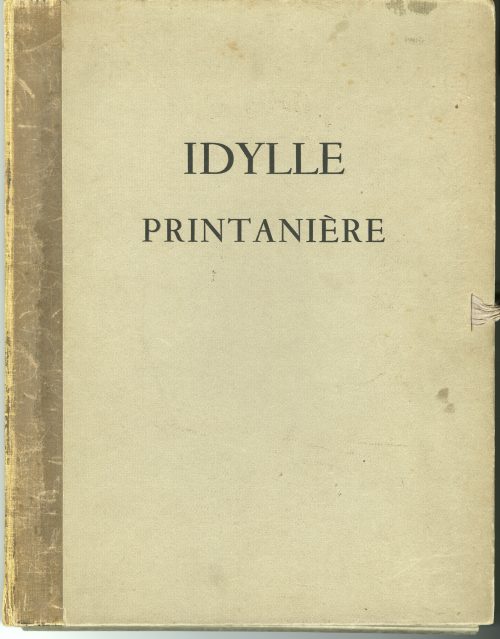 Title: IDYLLE | PRINTANIÈRE || Verso: {Headpiece} | Justification du tirage | {7 lines of text} | Exemplaire № 56 (digits by hand) | HP (monogram by hand) | {tailpiece} || Album of 30 hand-coloured lithographs and frontispiece in a cardboard folder; each sheet mounted in a 32.5 x 25 cm passepartout with 19 x 13 cm window; published in Paris in 1938 by Henri Pasquinelli (attributed). No artist, no publisher name indicated. According to Justification du tirage, the print run of 516 copies on Arches laid tinted paper (vergé), copy A – control artist’s uncoloured, 15 copies B–P reserved for collaborators and friends, copies 1–500 – for bibliophiles. This copy № 56, autographed by the publisher's monogram: "HP". Catalogue Raisonné: J.-P. Dutel, vol 2 (1920–1970), #1726, p. 207-8. Provenance: J.-P. Dutel.
Title: IDYLLE | PRINTANIÈRE || Verso: {Headpiece} | Justification du tirage | {7 lines of text} | Exemplaire № 56 (digits by hand) | HP (monogram by hand) | {tailpiece} || Album of 30 hand-coloured lithographs and frontispiece in a cardboard folder; each sheet mounted in a 32.5 x 25 cm passepartout with 19 x 13 cm window; published in Paris in 1938 by Henri Pasquinelli (attributed). No artist, no publisher name indicated. According to Justification du tirage, the print run of 516 copies on Arches laid tinted paper (vergé), copy A – control artist’s uncoloured, 15 copies B–P reserved for collaborators and friends, copies 1–500 – for bibliophiles. This copy № 56, autographed by the publisher's monogram: "HP". Catalogue Raisonné: J.-P. Dutel, vol 2 (1920–1970), #1726, p. 207-8. Provenance: J.-P. Dutel. -
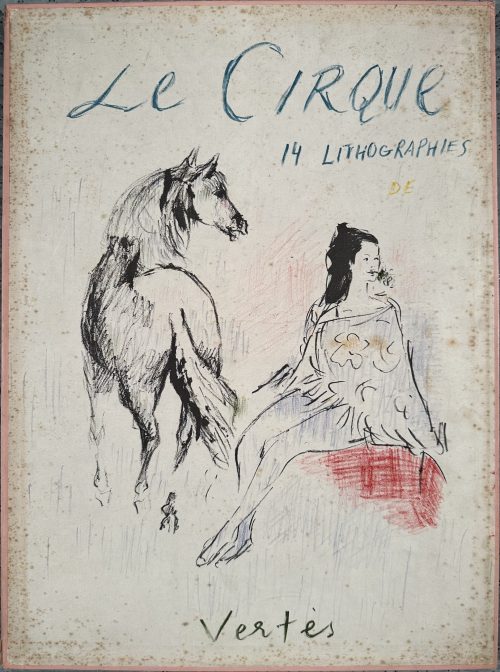 Publisher’s peach cloth box 555 x 410 mm with coloured lithograph on the lid, autographed with crayons "Le Cirque | 14 LITHOGRAPHIES | DE | {vignette} | Vertes"; in-folio unbound 4 pp. booklet on laid paper watermarked “Marais” and 14 loose leaves of plates on laid paper 520 x 395 mm without a watermark with coloured lithographs signed “Vertes” and numbered “195/250” in pencil; interleaved with tracing paper. Box and plates foxed. Title-page (red and black): LE | CIRQUE | 14 LITHOGRAPHIES DE | VERTÈS | PRÉSENTÉ | PAR | JEAN COCTEAU || Imprint: LES LIVES MERVEILLEUX | MONACO | Il a été tiré de cet album : | 150 Exemplaires, | destinés à | l'Amérique, | distribués bar les soins de | Arthur H. Harlow | de New-York, | & | 100 Exemplaires, | réservés à la France. | 15 Avril 1949 || Limitation: Edition limited to 250 copies (150 for USA, 100 for France); this is copy № 195 printed for France as the American copies marked “Published by Arthur H. Harlow & Co., New York. Seller’s Description: VERTÈS, Marcel (Hungarian-French, 1895-1961). Le Cirque 14 Lithographies de Vertès. Présénte par Jean Cocteau. [Monaco: Les Livres Merveilleux, 1949]. [vi] pp. With all 14 lithographs, each signed by the artist and numbered “195/250”. Text and lithographs 15 ¼ x 20 ½”. In original publisher’s peach cloth box with printed label on lid (box foxed, soiled, lightly worn; lithographs and text foxed). Still, a very good example of this lovely collection, with an introduction by Jean Cocteau (1889-1963). Catalogue Raisonné: Vokaer № 50. Marcel Vertès [Marcell Vértes] (Jewish-Hungarian-French, 1895 – 1961) – artist. Arthur H. Harlow (American, c. 1877 – 1958) – publisher. Jean Cocteau (French, 1889 – 1963) – author.
Publisher’s peach cloth box 555 x 410 mm with coloured lithograph on the lid, autographed with crayons "Le Cirque | 14 LITHOGRAPHIES | DE | {vignette} | Vertes"; in-folio unbound 4 pp. booklet on laid paper watermarked “Marais” and 14 loose leaves of plates on laid paper 520 x 395 mm without a watermark with coloured lithographs signed “Vertes” and numbered “195/250” in pencil; interleaved with tracing paper. Box and plates foxed. Title-page (red and black): LE | CIRQUE | 14 LITHOGRAPHIES DE | VERTÈS | PRÉSENTÉ | PAR | JEAN COCTEAU || Imprint: LES LIVES MERVEILLEUX | MONACO | Il a été tiré de cet album : | 150 Exemplaires, | destinés à | l'Amérique, | distribués bar les soins de | Arthur H. Harlow | de New-York, | & | 100 Exemplaires, | réservés à la France. | 15 Avril 1949 || Limitation: Edition limited to 250 copies (150 for USA, 100 for France); this is copy № 195 printed for France as the American copies marked “Published by Arthur H. Harlow & Co., New York. Seller’s Description: VERTÈS, Marcel (Hungarian-French, 1895-1961). Le Cirque 14 Lithographies de Vertès. Présénte par Jean Cocteau. [Monaco: Les Livres Merveilleux, 1949]. [vi] pp. With all 14 lithographs, each signed by the artist and numbered “195/250”. Text and lithographs 15 ¼ x 20 ½”. In original publisher’s peach cloth box with printed label on lid (box foxed, soiled, lightly worn; lithographs and text foxed). Still, a very good example of this lovely collection, with an introduction by Jean Cocteau (1889-1963). Catalogue Raisonné: Vokaer № 50. Marcel Vertès [Marcell Vértes] (Jewish-Hungarian-French, 1895 – 1961) – artist. Arthur H. Harlow (American, c. 1877 – 1958) – publisher. Jean Cocteau (French, 1889 – 1963) – author. -
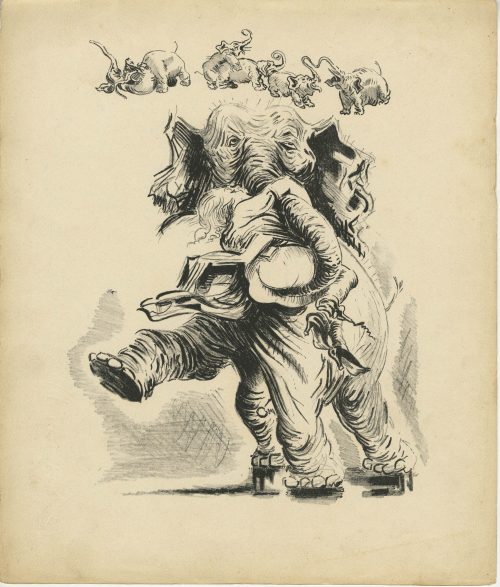
Album of 20 hand-coloured lithographs with a title page and a 'justification du tirage' page in an original snakeskin-clothed cardboard binder. Drawn on stone by Anonymous, attributed to Santippa. The theme of these pictures can be described as erotic humour.
Edition: 200 copies printed in Bruxelles, c. 1938; this copy without a number.
Watermarked wove paper: Word "Marais" and a flower.
Dimensions: 24.3 x 29.3 cm According to J.-P. Dutel, the author of these images is Georges Hoffmann under the pseudonym Santippa. Honesterotica provides a different name: Gaston Hoffmann [Santippa] (French, 1883 – 1977), which seems adequate. Catalogue raisonné: Dutel (1920-70): 2496. -
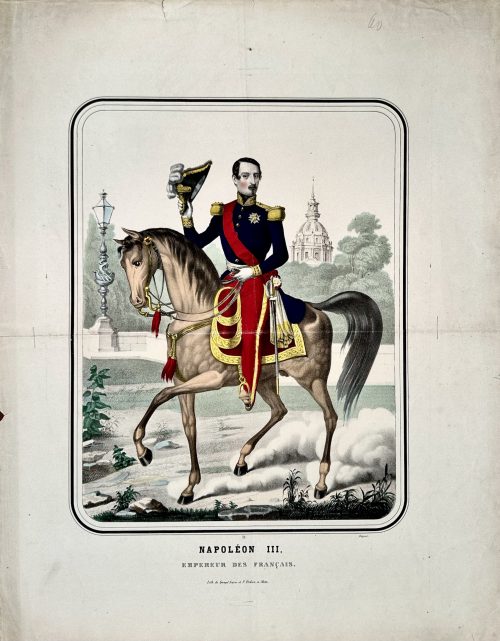 Hand-coloured chromolithography on wove paper, 600 x 470 mm; black ink stamp “4921” to reverse, horizontal and vertical centrefolds. Image of Napoléon III on horseback, in a frame; lettering under the frame: 34 — Déposé | NAPOLÉON III | EMPEREUR DES FRANÇAIS. | Lith. de Gangel frères et P. Didion, à Metz. || Gangel frères et P. Didion (Metz) – printer/publisher. Paulin Didion (French, 1831 – 1879)
Hand-coloured chromolithography on wove paper, 600 x 470 mm; black ink stamp “4921” to reverse, horizontal and vertical centrefolds. Image of Napoléon III on horseback, in a frame; lettering under the frame: 34 — Déposé | NAPOLÉON III | EMPEREUR DES FRANÇAIS. | Lith. de Gangel frères et P. Didion, à Metz. || Gangel frères et P. Didion (Metz) – printer/publisher. Paulin Didion (French, 1831 – 1879) -
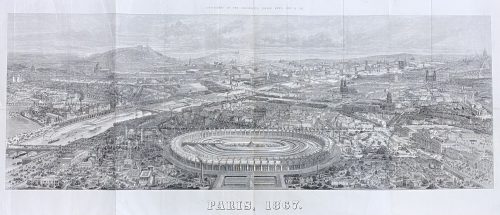
Lithography on paper by Charles Fichot (French, 1817 – 1903), published in a supplement to the Illustrated London News of July 6, 1867.
The construction on the foreground is the International Exposition of 1867 (Exposition universelle d'art et d'industrie de 1867). Dimensions: Sheet: 130 x 58 cm; Image: 118 x 43 cm. -
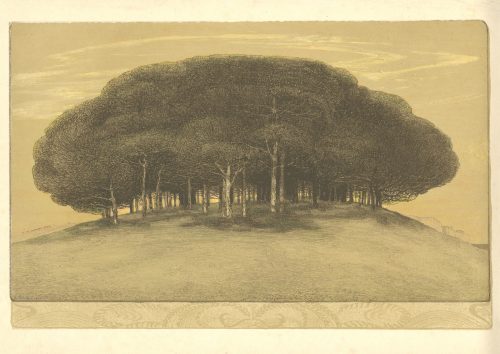 Colour (tone) lithography, image 268 x 410 mm, sheet 317 x 470 mm; signed on bottom-left of the image “Pelikan 1905”, and pencil ms inscription: E. Pelikan to the lower-right corner of the sheet. Contributor: Emilie Mediz-Pelikan (Austrian, 1861 – 1908) – artist. Seller's description: Austrian-German painter and graphic artist. Emilie Mediz-Pelikan was born in Vöcklabruck in 1861. She studied at the Vienna Academy and followed her teacher Albert Zimmermann to Salzburg and in 1885 to Munich. In 1891 she married the painter and graphic artist Karl Mediz (1868 - 1945), with whom she lived in Vienna and from 1894 in Dresden. She was in contact with the Dachau Artists' Colony and went on study trips to Paris, Belgium, Hungary and Italy. In the Dachau artists' colony she was friends with Adolf Hölzel and Fritz von Uhde. In 1889 and 1890 she spent time in Paris and in the Belgian artists' colony Knokke. In 1898 she was represented at the first art exhibition of the Vienna Secession, and in 1901 at the International Art Exhibition in Dresden. In 1903 she and her husband had a group exhibition, at the Hagenbund in Vienna. In 1904, she showed graphic works at the Dresden royal court art dealer Richter, and in 1905 and 1906 she exhibited at the Berlin Künstlerhaus. It was not until around 1900 that she achieved her artistic breakthrough with her landscape paintings. Since the estate of the artist, who died prematurely in Dresden in 1908, was lost in the former GDR until the 1980s, it was quite late that the artist was rediscovered and revalued both in Austrian art history and on the art market. In 1986, the first major exhibitions took place at the Upper Austrian State Museum and the University of Applied Arts in Vienna, followed by numerous smaller exhibitions in private galleries in Vienna, Linz and Munich. The artist received recognition during her lifetime from numerous prominent fellow painters as well as from the art critic Ludwig Hevesi. Together with Tina Blau, Herbert Boeckl, Marie Egner, Theodor von Hörmann, Franz Jaschke, Eugen Jettel, Ludwig Heinrich Jungnickel, Rudolf Junk, Gustav Klimt, Oskar Kokoschka, Johann Victor Krämer, Heinrich Kühn, Carl Moll, Rudolf Quittner, Rudolf Ribarz, Emil Jakob Schindler, Max Suppantschitsch, Max Weiler, Olga Wisinger-Florian and Alfred Zoff, she was a protagonist of the reception of Impressionism in Austria. This style went down in Austrian art history under the term "Stimmungsimpressionismus".
Colour (tone) lithography, image 268 x 410 mm, sheet 317 x 470 mm; signed on bottom-left of the image “Pelikan 1905”, and pencil ms inscription: E. Pelikan to the lower-right corner of the sheet. Contributor: Emilie Mediz-Pelikan (Austrian, 1861 – 1908) – artist. Seller's description: Austrian-German painter and graphic artist. Emilie Mediz-Pelikan was born in Vöcklabruck in 1861. She studied at the Vienna Academy and followed her teacher Albert Zimmermann to Salzburg and in 1885 to Munich. In 1891 she married the painter and graphic artist Karl Mediz (1868 - 1945), with whom she lived in Vienna and from 1894 in Dresden. She was in contact with the Dachau Artists' Colony and went on study trips to Paris, Belgium, Hungary and Italy. In the Dachau artists' colony she was friends with Adolf Hölzel and Fritz von Uhde. In 1889 and 1890 she spent time in Paris and in the Belgian artists' colony Knokke. In 1898 she was represented at the first art exhibition of the Vienna Secession, and in 1901 at the International Art Exhibition in Dresden. In 1903 she and her husband had a group exhibition, at the Hagenbund in Vienna. In 1904, she showed graphic works at the Dresden royal court art dealer Richter, and in 1905 and 1906 she exhibited at the Berlin Künstlerhaus. It was not until around 1900 that she achieved her artistic breakthrough with her landscape paintings. Since the estate of the artist, who died prematurely in Dresden in 1908, was lost in the former GDR until the 1980s, it was quite late that the artist was rediscovered and revalued both in Austrian art history and on the art market. In 1986, the first major exhibitions took place at the Upper Austrian State Museum and the University of Applied Arts in Vienna, followed by numerous smaller exhibitions in private galleries in Vienna, Linz and Munich. The artist received recognition during her lifetime from numerous prominent fellow painters as well as from the art critic Ludwig Hevesi. Together with Tina Blau, Herbert Boeckl, Marie Egner, Theodor von Hörmann, Franz Jaschke, Eugen Jettel, Ludwig Heinrich Jungnickel, Rudolf Junk, Gustav Klimt, Oskar Kokoschka, Johann Victor Krämer, Heinrich Kühn, Carl Moll, Rudolf Quittner, Rudolf Ribarz, Emil Jakob Schindler, Max Suppantschitsch, Max Weiler, Olga Wisinger-Florian and Alfred Zoff, she was a protagonist of the reception of Impressionism in Austria. This style went down in Austrian art history under the term "Stimmungsimpressionismus". -
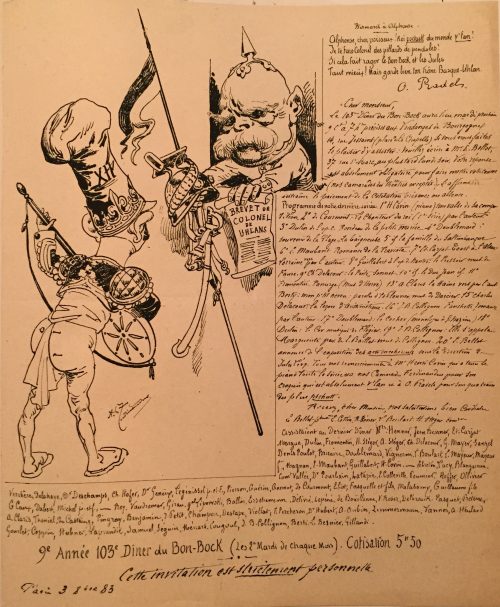
The 103rd Bon Bock Dinner Invitation
Artist: François Avenet a.k.a. Alexandre Ferdinandus (French, 1850 – 1888).
Cher monsieur, Le 103ème Dîner du Bon-Bock aura lieu mardi prochain / à 7h précises aux Vendanges de Bourgognel / 14, rue Jessaint (place de la Chapelle). Si vous nous faites le plaisir d’y assister : Veuillez écrire à Mr. E. Bellot, / 37 rue St Marc, au plus tard lundi soir. Votre réponse / est absolument obligatoire pour faire mettre votre couvert (nos camarades des théâtres exceptés.) L’affirmative entraine le paiement de la cotisation présence ou absence. / Programme de notre dernière soirée. 1e H Covin (piano) une valse de sa compo- / sition. 2e de Courment : Le Chanteur du roi (1ère série) par l’auteur. / 3e Dulin de l’o.p.e. Rondeau de la petite mariée 4e Doublemard : / souvenir de la Plage La baigneuse 5e "la famille des Saltimbanque" / 6e C. Maubant Romance de la Traviata. 7e Ct. Carjat Toast à l’Alsace-/Lorraine vers par l’auteur. 8e Guillabert de l’ap. de Nantes : le Pressoir mud. de / Faure . 9e Ch. Delacour : le Poete, Sonnet. 10e if. le Duc Jean if. 11e / Fromentin. Panurge (Mus. d’Hervé) 13e A. Claris la Haine vers par l’aut. / Benty : mon p’tit neveu : paroles d’Po Clouvier. mus. de Darcier. 15e Charles / Delacour : la leçon d’Arithmétique. 16e J.B. Collegnon Fanchette, romance/ par l’auteur. 17e Doublemard : le Cocher (monologue de P. Marzin) 18e / Dulin : le Cor musique de Flégier. 19e J. M. Collignon : Elle s’appela/ Marguerite par. De L. Baillet mus de Collignon. 20e L. Bellot / annonce de l’exposition des arts incohérents sous la direction de / Jules Féry. Tous nos remerciements à Mr. Henri Covin qui a tenu le/ piano toute la soirée et a nos Camarades Ferdinandus pour son / croquis qui est absolument v’lan et à O. Pradels pour son quatrain/ des plus pachutt. // Recevez, cher Monsieur, nos salutations bien Cordiale / E. Bellot, G durater E. Cottin, R. Géner, L. Bocilart, H. Héger comba / assistaient au Dernier Dîner Mrs : Henner, Jean Brenner, Et. Carjat / Margue, Dulin, Fromentin, H. Stéger, A . Stéger, eh. Delacour, G. Mayer, Sanzel/ Denis Poulot, Bricaire, Doublemard, Vigneron, T. Boulart, L. Mayeur, Mayeur/ flle, Magnan, E. Maubant, Guillabert, H. Corin. ___ Lebreton, Tucy, Blangarnon. / Comt. Vallée, Dr Pourbain, Latapie, E. Colleville, Roumier, Hoffer, Ollivier / Verchère, Delhaye, Dr Deschamps, Ch. Hofer, Dr Geneirp, Péginissel p, et F. , Pierson, Guérin, Cronnot, de Courmont, Eliot, Fasquelle et filsm Malasamy, Guillaume fils /G Caux, Dabert, Michel p, et f.s, ___Rey. Vaundremer, Girau, general Lipovvski, Ballin, Ersetemenn, Délivré, Lepéné, de Bouillanne, V. Roser, Delbroueth. Pasquet, Treterre, / A. Claris, Thoniel, du Castaings, Pingray, Benjamin, I. Petit, Champon, Destape, Viotlat, F. Percheron, Dr Hubert, A. Aubin, Zimmermann, Vannes, A. Heulard, / Gourlet, Coppin, Hubner, laprandie, Samuel, Séguin, Ménard, Cougoul, J. B. Collignon, Beri L. Besnier, Gillandi. // 9e Année 103e Diner du Bon-Bock (Les 2e Mardi de Chaque Mois). Cotisation 5h50 / Cette invitation est strictement personnelle / Paris 3 8bre 83.Bismarck à Alphonse
Alphonse, cher poissure! Roi pschutt du monde u’lan! Je te fais Colonel des pillards de pendules! Si cela fait rager le Bon-Bock et les Jules Tant mieux! Mais garde bien to Trône Basque-Uhlan. O. Pradels.
Bismarck to Alphonse Alphonse, dear annoyance! King shushh from the Uh'lan world I name you Colonel of the looters of pendulums! If this makes the Bon-Bock and Jules angry All the better! But protect your Basque-Uhlan throne well. O. Pradels.
Dear sir, The 103rd Dinner of the Bon-Bock will take place next Tuesday at 7 pm precisely at the Grape Harvest of Bourgognel, 14, Jessaint street (la Chapelle plaza). If you would do us the honour of coming: Please write to Mr E. Bellot, 37 St Marc street, on Monday night at the latest. Your answer is absolutely mandatory to prepare the place settings (our friends from the theatres excluded.) The 'yes' comes with a payment of the due whether or not you end up attending. Program for our last evening. 1st – H. Covin (piano) a waltz composed by him. 2nd – Courment: Le Chanteur du roi (King's singer) (1st series) by the author. 3rd – Dulin: Rondeau from opera "Le petite mariée" (The Little Bride) 4th – Doublemard: Memory of the bather's beach 5th – "The Saltimbanque family" 6th – Maubant: Romance of "La Traviata". 7th – Étienne Carjat Toast to the Alsace-Lorraine, verses by the author. 8th – Guillabert from the opera "Nantes: le Press mud" by Fauré. 9th – Charles Delacour: the Poet, Sonnet. 10th – "Duke Jean" 11th – Fromentin. Panurge (Mus. of Hervé) 13th – A. Claris "The Hatred" verses by the author, Benty: my lil’ nephew: lyrics by Clouvier, music by Darcier. 15th – Charles Delacour: the lesson in arithmetic. 16th – J.-B.Collegnon, "Fanchette", romance by the author. 17th – Doublemard: the Coach driver (monologue by P. Marzin). 18th – Dulin: the horn music by Flégier. 19th – J.-B. Collignon: "Her name was Marguerite", lyrics by L. Baillet music by Collignon. 20th – L. Bellot, an announcement from the incoherent arts exhibition curated by Jules Férry. All of our thanks to Mr Henri Covin who played the piano all night and to our Friends Ferdinandus for his sketch that is absolutely bam and to O. Pradels for his quatrain among the most pazazz worthy. We send you our most cordial salutation, Monsieur. E. Bellot, G. Durater, E. Cottin, R. Géner, L. Bocilart, H. Héger, Henner, Jean Brenner, Et. Carjat, Margue, Dulin, Fromentin, H. Stéger, A . Stéger, Ch. Delacour, G. Mayer, Sanzel, Denis Poulot, Bricaire, Doublemard, Vigneron, T. Boulart, L. Mayeur, Mayeur daugter, Magnan, E. Maubant, Guillabert, H. Corin. Lebreton, Tucy, Blangarnon. Comt. Vallée, Dr Pourbain, Latapie, E. Colleville, Roumier, Hoffer, Ollivier, Verchère, Delhaye, Dr. Deschamps, Ch. Hofer, Dr. Geneirp, Péginissel père et fils, Pierson, Guérin, Cronnot, de Courmont, Eliot, Fasquelle et fils Malasamy, Guillaume fils, G. Caux, Dabert, Michel père et fils, Rey. Vaundremer, Girau, General Lipovvski, Ballin, Ersetemenn, Délivré, Lepéné, de Bouillanne, V. Roser, Delbroueth, Pasquet, Treterre, A. Claris, Thoniel, du Castaings, Pingray, Benjamin, J. Petit, Champon, Destape, Viotlat, F. Percheron, Dr. Hubert, A. Aubin, Zimmermann, Vannes, A. Heulard, Gourlet, Coppin, Hubner, Laprandie, Samuel, Séguin, Ménard, Cougoul, J. B. Collignon, Berti, Besnier, Gillandi. 9th Year 103rd Dinner of the Bon-Bock (The 2nd Tuesdays of Each Month). Due 5:50 pm. This invitation is strictly personal. Paris 3 October 1883. Bismarck hands a certificate for the title of colonel along with a lance, an Uhlan helmet (Polish cavalry) and a sword to a joker. The joker wears a traditional Polish folk hat inscribed with 'XIV' and holds a guitar. ______ Comments: Émile Bellot [L. Bellot] (French, the second half of the 19th century) – engraver, model for a painting by Édouard Manet "Le bon bock", the founder of Le Bon Bock Dinner. Covin, Henri (French, 1845 – 1887) – Musician, arranger. Étienne Carjat (French, 1828 – 1906) – Journalist, caricaturist and photographer. Charles Delacour (French, 18.. – 1898) – Composer. Jean-Baptiste Collignon (French, 18..-1906) – Composer. Ange Flégier (French, 1846 – 1927) – Composer. Joseph Darcier (French, 1819 – 1883) – Composer, singer and actor. Le petite mariée (The Little Bride) – a three-act opéra-bouffe, music by Charles Lecocq, libretto by Eugène Leterrier and Albert Vanloo. La plage de la Baigneuse – beach of Saint Jean de Monts in the Vendée department in the Pays de la Loire region in western France. La Famille du Saltimbanque: L'Enfant Blessé – The Family of Street Acrobats: the Injured Child – painting by Gustave Doré (French, 1832 – 1883) produced in 1873. Henri-Polydore Maubant (1821-1902) – actor, vocalist (baritone) Gabriel Urbain Fauré (French, 1845 – 1924) – French composer, organist, pianist, and teacher. Hervé [Louis Auguste Florimond Ronger] (French, 1825 – 1892) – French singer, composer, librettist, conductor and scene painter, inventor of the genre of operetta in Paris. -
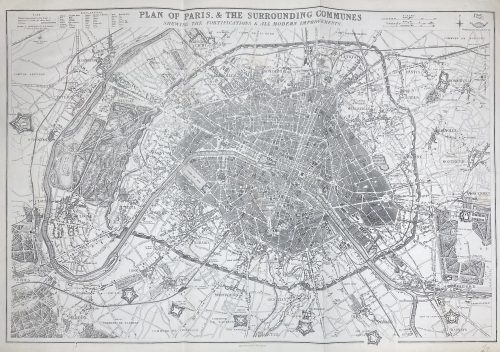 PLAN OF PARIS & THE SURROUNDING COMMUNES | SHEWING THE FORTIFICATIONS & ALL MODERN IMPROVEMENTS. || Lettered above the image with title, and below with production detail: "Day & Son, Lithrs to the Queen"; and production detail above: "Drawn & Engraved by B.R. Davies: / 16 George Str Euston Squ London", and on top right: "Weekly Dispatch Atlas, 138 Fleet Str". Dimensions: 47.5 x 65.4 cm. Contributors: Day & Son; William Day (British, 1797 – 1845) – lithographer, printer. Davies, Benjamin Rees (British, 1789 – 1872) – artist, engraver.
PLAN OF PARIS & THE SURROUNDING COMMUNES | SHEWING THE FORTIFICATIONS & ALL MODERN IMPROVEMENTS. || Lettered above the image with title, and below with production detail: "Day & Son, Lithrs to the Queen"; and production detail above: "Drawn & Engraved by B.R. Davies: / 16 George Str Euston Squ London", and on top right: "Weekly Dispatch Atlas, 138 Fleet Str". Dimensions: 47.5 x 65.4 cm. Contributors: Day & Son; William Day (British, 1797 – 1845) – lithographer, printer. Davies, Benjamin Rees (British, 1789 – 1872) – artist, engraver. -
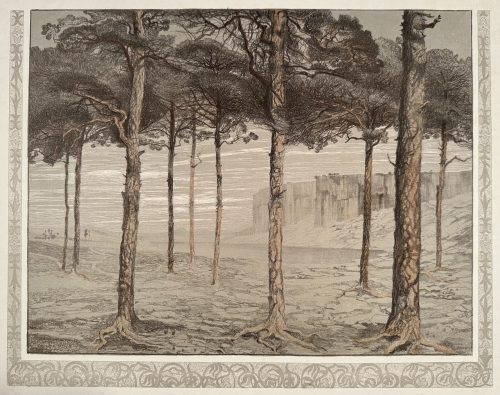 Colour (tone) lithography, image 396 x 508 mm, sheet 532 x 654 mm; before signature, undated; pencil ms inscription: Föhrenhain — E. Pelikan / 200M to the lower-right corner of the sheet. Contributor: Emilie Mediz-Pelikan (Austrian, 1861 – 1908) – artist. Seller's description: Austrian-German painter and graphic artist. Emilie Mediz-Pelikan was born in Vöcklabruck in 1861. She studied at the Vienna Academy and followed her teacher Albert Zimmermann to Salzburg and in 1885 to Munich. In 1891 she married the painter and graphic artist Karl Mediz (1868 - 1945), with whom she lived in Vienna and from 1894 in Dresden. She was in contact with the Dachau Artists' Colony and went on study trips to Paris, Belgium, Hungary and Italy. In the Dachau artists' colony she was friends with Adolf Hölzel and Fritz von Uhde. In 1889 and 1890 she spent time in Paris and in the Belgian artists' colony Knokke. In 1898 she was represented at the first art exhibition of the Vienna Secession, and in 1901 at the International Art Exhibition in Dresden. In 1903 she and her husband had a group exhibition, at the Hagenbund in Vienna. In 1904, she showed graphic works at the Dresden royal court art dealer Richter, and in 1905 and 1906 she exhibited at the Berlin Künstlerhaus. It was not until around 1900 that she achieved her artistic breakthrough with her landscape paintings. Since the estate of the artist, who died prematurely in Dresden in 1908, was lost in the former GDR until the 1980s, it was quite late that the artist was rediscovered and revalued both in Austrian art history and on the art market. In 1986, the first major exhibitions took place at the Upper Austrian State Museum and the University of Applied Arts in Vienna, followed by numerous smaller exhibitions in private galleries in Vienna, Linz and Munich. The artist received recognition during her lifetime from numerous prominent fellow painters as well as from the art critic Ludwig Hevesi. Together with Tina Blau, Herbert Boeckl, Marie Egner, Theodor von Hörmann, Franz Jaschke, Eugen Jettel, Ludwig Heinrich Jungnickel, Rudolf Junk, Gustav Klimt, Oskar Kokoschka, Johann Victor Krämer, Heinrich Kühn, Carl Moll, Rudolf Quittner, Rudolf Ribarz, Emil Jakob Schindler, Max Suppantschitsch, Max Weiler, Olga Wisinger-Florian and Alfred Zoff, she was a protagonist of the reception of Impressionism in Austria. This style went down in Austrian art history under the term "Stimmungsimpressionismus".
Colour (tone) lithography, image 396 x 508 mm, sheet 532 x 654 mm; before signature, undated; pencil ms inscription: Föhrenhain — E. Pelikan / 200M to the lower-right corner of the sheet. Contributor: Emilie Mediz-Pelikan (Austrian, 1861 – 1908) – artist. Seller's description: Austrian-German painter and graphic artist. Emilie Mediz-Pelikan was born in Vöcklabruck in 1861. She studied at the Vienna Academy and followed her teacher Albert Zimmermann to Salzburg and in 1885 to Munich. In 1891 she married the painter and graphic artist Karl Mediz (1868 - 1945), with whom she lived in Vienna and from 1894 in Dresden. She was in contact with the Dachau Artists' Colony and went on study trips to Paris, Belgium, Hungary and Italy. In the Dachau artists' colony she was friends with Adolf Hölzel and Fritz von Uhde. In 1889 and 1890 she spent time in Paris and in the Belgian artists' colony Knokke. In 1898 she was represented at the first art exhibition of the Vienna Secession, and in 1901 at the International Art Exhibition in Dresden. In 1903 she and her husband had a group exhibition, at the Hagenbund in Vienna. In 1904, she showed graphic works at the Dresden royal court art dealer Richter, and in 1905 and 1906 she exhibited at the Berlin Künstlerhaus. It was not until around 1900 that she achieved her artistic breakthrough with her landscape paintings. Since the estate of the artist, who died prematurely in Dresden in 1908, was lost in the former GDR until the 1980s, it was quite late that the artist was rediscovered and revalued both in Austrian art history and on the art market. In 1986, the first major exhibitions took place at the Upper Austrian State Museum and the University of Applied Arts in Vienna, followed by numerous smaller exhibitions in private galleries in Vienna, Linz and Munich. The artist received recognition during her lifetime from numerous prominent fellow painters as well as from the art critic Ludwig Hevesi. Together with Tina Blau, Herbert Boeckl, Marie Egner, Theodor von Hörmann, Franz Jaschke, Eugen Jettel, Ludwig Heinrich Jungnickel, Rudolf Junk, Gustav Klimt, Oskar Kokoschka, Johann Victor Krämer, Heinrich Kühn, Carl Moll, Rudolf Quittner, Rudolf Ribarz, Emil Jakob Schindler, Max Suppantschitsch, Max Weiler, Olga Wisinger-Florian and Alfred Zoff, she was a protagonist of the reception of Impressionism in Austria. This style went down in Austrian art history under the term "Stimmungsimpressionismus". -
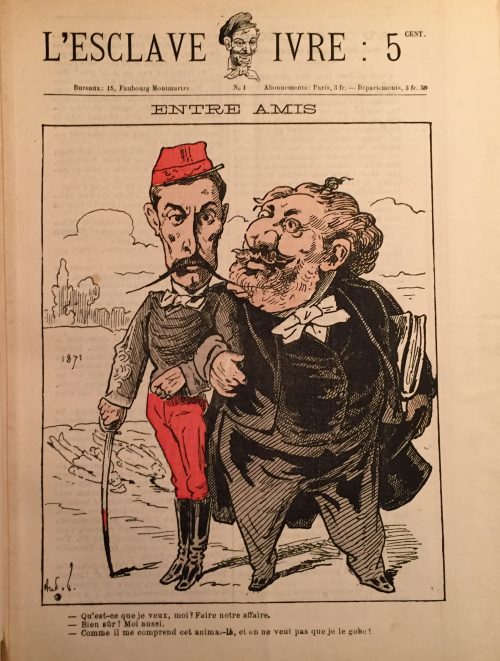 Artist: André Gill [real name Louis-André Gosset] (French, 1840 – 1885). L'Esclave Ivre [The Drunken Slave] was a Parisian weekly, published in 1881, 4 issues total. Léon Gambetta (French, 1838 – 1882) stands arm in arm with Marshal Patrice de MacMahon (French, 1808 – 1893). Dead bodies of communards lie in the midground and a landscape is faintly perceived in the background. 1871 is written on the hill on the left. L'Esclave Ivre, Issue 1. Entre Amis. Text below the image: - Qu'est-ce que je veux, moi? Faire notre affaire. / - Bien sûr! Moi aussi. / - Comme il me comprend cet animal-là, et on ne veut pas que je le gobe! [In between friends / - What do I want? To make a deal. / - Of course! Me too. / - How well this animal understands me, and we do not want me to swallow him!]
Artist: André Gill [real name Louis-André Gosset] (French, 1840 – 1885). L'Esclave Ivre [The Drunken Slave] was a Parisian weekly, published in 1881, 4 issues total. Léon Gambetta (French, 1838 – 1882) stands arm in arm with Marshal Patrice de MacMahon (French, 1808 – 1893). Dead bodies of communards lie in the midground and a landscape is faintly perceived in the background. 1871 is written on the hill on the left. L'Esclave Ivre, Issue 1. Entre Amis. Text below the image: - Qu'est-ce que je veux, moi? Faire notre affaire. / - Bien sûr! Moi aussi. / - Comme il me comprend cet animal-là, et on ne veut pas que je le gobe! [In between friends / - What do I want? To make a deal. / - Of course! Me too. / - How well this animal understands me, and we do not want me to swallow him!] -
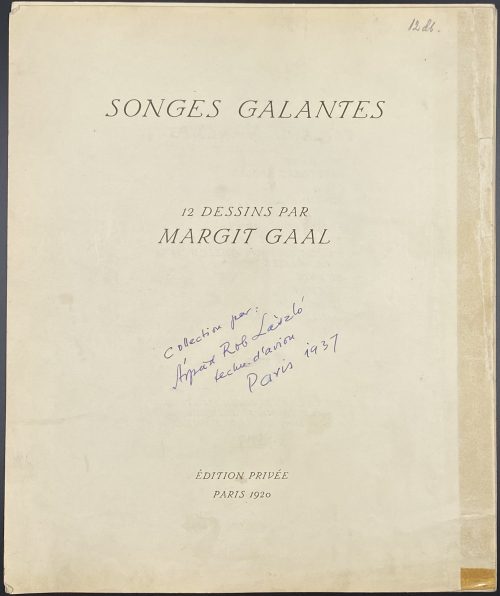 In an owner’s quarter buckram cardboard folder with a vegetation diaper design, ms blue ink lettering to front: “Songes galantes | 12 dessins par | Margit Gaal” at the centre, “Arpad Rob Laszlo | à Paris | 1938” in the lower right corner. Loose sheets with the 1st leaf t.p. / table de planches, and then 12 leaves of lithograph plates. Title-page: SONGES GALANTES | 12 DESSINS PAR | MARGIT GAAL | ÉDITION PRIVÉE | PARIS 1920 ||, ms inscription in blue ink in the middle : “Collection par | Árpad Rob Laśzló | techn. d’avion | Paris 1937”. Limitation: Edition limited to 500 copies of which № 1-100 signed by the author. This is copy № 407. References: Dutel (1920-1970) № 1413 (published in 1921); Honesterotica (indicated the year of death as 1965, however, there is no proof). Contributors: Gaál, Margit (Hungarian, 1898 – 1920) – artist.
In an owner’s quarter buckram cardboard folder with a vegetation diaper design, ms blue ink lettering to front: “Songes galantes | 12 dessins par | Margit Gaal” at the centre, “Arpad Rob Laszlo | à Paris | 1938” in the lower right corner. Loose sheets with the 1st leaf t.p. / table de planches, and then 12 leaves of lithograph plates. Title-page: SONGES GALANTES | 12 DESSINS PAR | MARGIT GAAL | ÉDITION PRIVÉE | PARIS 1920 ||, ms inscription in blue ink in the middle : “Collection par | Árpad Rob Laśzló | techn. d’avion | Paris 1937”. Limitation: Edition limited to 500 copies of which № 1-100 signed by the author. This is copy № 407. References: Dutel (1920-1970) № 1413 (published in 1921); Honesterotica (indicated the year of death as 1965, however, there is no proof). Contributors: Gaál, Margit (Hungarian, 1898 – 1920) – artist. -
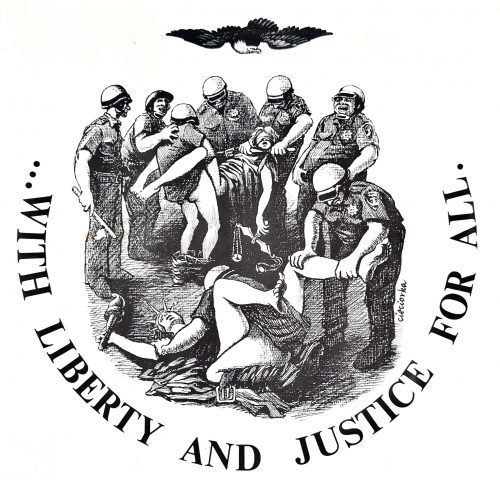 Offset lithography in back ink on paper, 448 x 448 mm, description by OMCA COLLECTIONS (Oakland Museum of California): The top edge of the poster has a stylized drawing of an eagle. Below, the poster has a drawing with eight male police officers and two female figures: one with the crown and torch of the Statue of Liberty, the other holding scales and wearing a blindfold in the style of personifications of justice. In the foreground of the drawing, one of the police officers is holding the liberty figure on the ground and raping her while a second officer holds one of her legs. In the background, the justice figure is being held up and raped by two officers. The rest of the police officers look at this scene and laugh or pat one another on the back. The bottom of the drawing is bordered by a semicircle of text that reads: "...WITH LIBERTY AND JUSTICE FOR ALL." [...] This provocative poster was described at a 1968 House Un-American Activities Committee (HUAC) hearing as "one of the most vile, obscene pieces of literature that I have seen disseminated in San Francisco" by San Francisco Examiner reporter Edward S. Montgomery. Contributors: Frank Cieciorka (American, 1939 – 2008) – artist.
Offset lithography in back ink on paper, 448 x 448 mm, description by OMCA COLLECTIONS (Oakland Museum of California): The top edge of the poster has a stylized drawing of an eagle. Below, the poster has a drawing with eight male police officers and two female figures: one with the crown and torch of the Statue of Liberty, the other holding scales and wearing a blindfold in the style of personifications of justice. In the foreground of the drawing, one of the police officers is holding the liberty figure on the ground and raping her while a second officer holds one of her legs. In the background, the justice figure is being held up and raped by two officers. The rest of the police officers look at this scene and laugh or pat one another on the back. The bottom of the drawing is bordered by a semicircle of text that reads: "...WITH LIBERTY AND JUSTICE FOR ALL." [...] This provocative poster was described at a 1968 House Un-American Activities Committee (HUAC) hearing as "one of the most vile, obscene pieces of literature that I have seen disseminated in San Francisco" by San Francisco Examiner reporter Edward S. Montgomery. Contributors: Frank Cieciorka (American, 1939 – 2008) – artist. -
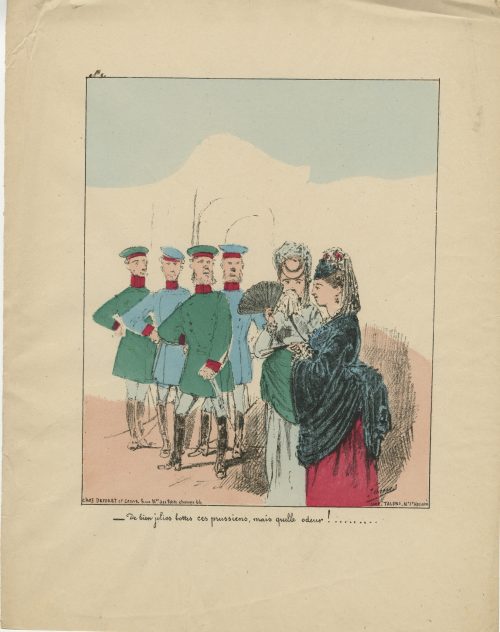 Artist: James (nothing else is known). According to Maurice Quentin-Bouchart (p. 95), this is sheet №2 of only two known caricatures by James except for Collection Wentzell (publisher) of 14 sheets. Text: De bien jolies bottes, ces Prussiens, mais quelle odeur!..... [What beautiful boots these Prussians have, but what an odour!.....] Two women from the bourgeoisie stand in front of a line of Prussian officers. One covers her nose with a handkerchief and hides what she is saying from the men with her fan.
Artist: James (nothing else is known). According to Maurice Quentin-Bouchart (p. 95), this is sheet №2 of only two known caricatures by James except for Collection Wentzell (publisher) of 14 sheets. Text: De bien jolies bottes, ces Prussiens, mais quelle odeur!..... [What beautiful boots these Prussians have, but what an odour!.....] Two women from the bourgeoisie stand in front of a line of Prussian officers. One covers her nose with a handkerchief and hides what she is saying from the men with her fan. -
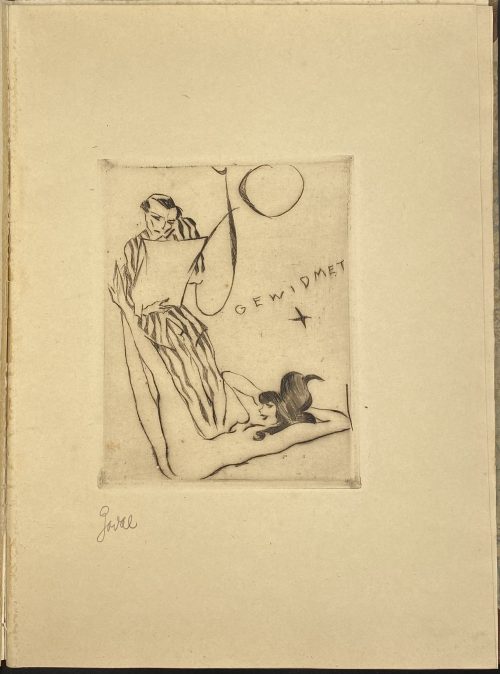 Half calf binding 33.5 x 25 cm, gilt lettering within rules “GODAL | JO”, engraved title-page and 9 etchings printed in sepia on sheets 32.5 x 24 cm of thick wove paper, pencil signed, presumably, by the artist; a newspaper clipping tipped-in. The number of copies is unknown. Ticket to front pastedown: "Haeusgen |8 München 90 | Reinekestrasse 36" According to seller: “Extraordinarily rare series of erotic original etchings. - Cf. Bilderlexikon II, 451 u. Vollmer II, 261 - According to KVK not in any library”. Contributors: Erich Godal [Erich Goldbaum] (German-Jewish, 1899 – 1969) – artist.
Half calf binding 33.5 x 25 cm, gilt lettering within rules “GODAL | JO”, engraved title-page and 9 etchings printed in sepia on sheets 32.5 x 24 cm of thick wove paper, pencil signed, presumably, by the artist; a newspaper clipping tipped-in. The number of copies is unknown. Ticket to front pastedown: "Haeusgen |8 München 90 | Reinekestrasse 36" According to seller: “Extraordinarily rare series of erotic original etchings. - Cf. Bilderlexikon II, 451 u. Vollmer II, 261 - According to KVK not in any library”. Contributors: Erich Godal [Erich Goldbaum] (German-Jewish, 1899 – 1969) – artist.


